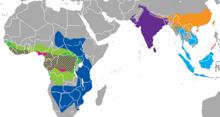Our website is made possible by displaying online advertisements to our visitors.
Please consider supporting us by disabling your ad blocker.
Smutsia
| Smutsia | |
|---|---|

| |
| Pangolins from genus Smutsia | |
| Scientific classification | |
| Domain: | Eukaryota |
| Kingdom: | Animalia |
| Phylum: | Chordata |
| Class: | Mammalia |
| Order: | Pholidota |
| Family: | Manidae |
| Subfamily: | Smutsiinae Gray, 1873[3] |
| Genus: | Smutsia Gray, 1865[2] |
| Type species | |
| Smutsia gigantea Illiger, 1815
| |
| Species | |
| |

| |
| Synonyms | |
|
synonyms of subfamily:
| |
African ground pangolin (Smutsia - "Smuts's animal") is a genus of pangolins from subfamily Smutsiinae within family Manidae. It was formerly considered a subgenus of genus Manis.[4] Its members are the more terrestrial of the African pangolins.[5] In past, this genus was also present in Europe.[6]
Description
The Smutsia species can be easily distinguished due to the layer of protective horny scales. They have a long streamlined body, its small coned shaped head, and thick tails that are covered with overlapping scales that resemble artichoke leaves. The color of these scales are between a yellow and brown color and are composed of fused hairs. These scales are often important to this species, when it feels threatened, they will roll itself into an impenetrable ball and the sharp scales are left exposed to the predator.
Diet and nutrition
The ground pangolins are carnivorous animals that only eat termites and ants and oftentimes will also eat larvae and other soft-bodied insects.
Mating life
Ground pangolins are described as polygynous animals which means when one male mates with multiple females but females can only mate with a single male. During the mating process, gestation may occur for 139 days until one young is born. The setting in which this occurs is an underground shelter until the babies reach 2 to 4 weeks then they are carried outside. The baby will stay with its mother until it reaches 3 months of birth. Pups are able to start the breeding process until they are 5–7 years old.
- ^ Cite error: The named reference
Heighton2023was invoked but never defined (see the help page). - ^ Gray, J. E. (1865). "Revision of the genera and species of entomophagous edentata, founded on the examination of the specimens in the British Museum". Proceedings of the Zoological Society: 359–386.
- ^ Gray, J. E. (1873). "Hand-list of the edentate, thick-skinned and ruminant mammals in the British Museum". London, Printed by order of the Trustees: 1–176.
{{cite journal}}: Cite journal requires|journal=(help) - ^ Schlitter, D.A. (2005). "Order Pholidota". In Wilson, D.E.; Reeder, D.M (eds.). Mammal Species of the World: A Taxonomic and Geographic Reference (3rd ed.). Johns Hopkins University Press. pp. 530–531. ISBN 978-0-8018-8221-0. OCLC 62265494.
- ^ du Toit, Z.; du Plessis, M.; Dalton, D. L.; Jansen, R.; Paul Grobler, J.; Kotzé, A. (2017). "Mitochondrial genomes of African pangolins and insights into evolutionary patterns and phylogeny of the family Manidae". BMC Genomics. 18 (1): 746. doi:10.1186/s12864-017-4140-5. PMC 5609056. PMID 28934931.
- ^ "Two-Million-Year-Old Pangolin Fossil Found in Romania | Sci.News". 12 January 2022.
Previous Page Next Page


